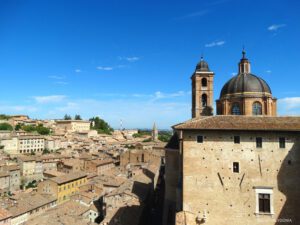The best travel experiences in Italy
Urbino, Italy: All You Must Know Before You Go
Urbino is one of Italy’s hidden treasures, offering a blend of rich history, art, and breathtaking architecture. Located in the central Marche region, Urbino is a perfect destination for travelers who appreciate art, history, and the charm of small towns. In this comprehensive guide, we will explore everything you need to know before visiting Urbino, from its top attractions to practical travel tips.
1. Introduction to Urbino
1.1 A Rich History
Urbino has been a significant cultural and historical center for centuries. Originally founded as a Roman settlement, it grew into prominence during the Renaissance as the seat of the Montefeltro family. Under their rule, Urbino became a leading center for art and culture, attracting some of Italy’s finest artists and intellectuals. Federico da Montefeltro, the Duke of Urbino, turned the city into a cultural hub, commissioning art, architecture, and the construction of notable buildings like the Ducal Palace.
Today, Urbino is a UNESCO World Heritage Site, well-preserved and still full of Renaissance charm, making it a fascinating destination for any visitor.
1.2 Why Visit Urbino?
Urbino is a city that combines the allure of history with the tranquility of a small, relatively undiscovered town. It’s perfect for those who want to explore a less crowded, more authentic side of Italy. Whether you’re an art lover, a history enthusiast, or simply someone looking for a peaceful getaway, Urbino has something to offer. From Renaissance art to charming cobblestone streets, there’s a unique beauty in exploring this town.
2. The Top Attractions in Urbino
2.1 The Ducal Palace (Palazzo Ducale)
Palazzo Ducale, the Duke’s former residence, is the crown jewel of Urbino’s architecture. Built in the 15th century by Federico da Montefeltro, this grand palace is a remarkable example of Renaissance architecture and design. The palace’s Studiolo, a small study room filled with intricate woodwork, and its impressive Galleria Nazionale delle Marche, featuring works by Raphael and Piero della Francesca, are highlights for any visitor.
2.1.1 Key Features of the Ducal Palace
- Studiolo of Federico da Montefeltro: This small, decorated room is a symbol of the Duke’s intellectual and artistic aspirations.
- Galleria Nazionale delle Marche: A museum housing works by Piero della Francesca, Raphael, and other Renaissance artists.
2.2 The Cathedral of Urbino (Cattedrale di Santa Maria Assunta)
The Urbino Cathedral, also known as Cattedrale di Santa Maria Assunta, is a stunning example of Renaissance religious architecture. It was rebuilt in the 16th century, after the original church was destroyed by an earthquake. The cathedral’s interior is rich with artworks and historical significance.
2.2.1 Highlights of the Cathedral
- Altarpiece by Piero della Francesca: One of the most iconic works in the cathedral, offering a glimpse into the artist’s mastery.
- Frescoes: The cathedral’s ceilings and walls are adorned with beautiful frescoes, adding to the spiritual atmosphere of the space.
2.3 The House of Raphael (Casa Natale di Raffaello)
Urbino is famously the birthplace of Raphael, one of the most influential painters of the Renaissance. His childhood home is now a museum dedicated to his life and early works. Visiting the Casa Natale di Raffaello allows visitors to step into the world of this iconic artist and see how the city influenced his development.
2.3.1 What to See at the House of Raphael
- Early Works of Raphael: The museum displays some of Raphael’s early paintings and sketches, showcasing his beginnings as an artist.
- Historical Artifacts: Visitors can learn about Raphael’s life, the artistic milieu of Urbino, and the Renaissance period through various exhibits.
2.4 The Oratory of St. John the Baptist (Oratorio di San Giovanni Battista)
A hidden gem, the Oratory of St. John the Baptist is a small chapel dating back to the 15th century. The chapel is adorned with frescoes by Lorenzo Salimbeni, making it a must-see for anyone interested in Renaissance art. It’s an intimate space where visitors can enjoy the peaceful atmosphere and admire the fine artwork.
2.4.1 Highlights of the Oratory
- Frescoes by Lorenzo Salimbeni: The walls are covered with beautiful frescoes that tell the story of St. John the Baptist.
- Tranquil Atmosphere: The chapel’s small, serene setting provides an ideal space for reflection.
2.5 The Albornoz Fortress (Rocca Albornoz)
Overlooking Urbino is the Albornoz Fortress, a medieval stronghold built in the 14th century. While it has served many purposes throughout history, today it offers one of the best panoramic views of the city and its surrounding countryside. A visit to the fortress is a great way to understand Urbino’s strategic importance and enjoy breathtaking views.
2.5.1 Highlights of the Albornoz Fortress
- Panoramic Views: From the fortress, visitors can enjoy sweeping views of Urbino and the surrounding Marche region.
- Exploration of the Ramparts: Walk along the fortress walls to experience the fortress’ medieval architecture firsthand.
2.6 The Arch of Augustus (Arco di Augusto)
The Arch of Augustus is an ancient Roman monument that marks the entrance to Urbino. Although it has undergone significant restoration over the years, it remains one of the city’s most important historical landmarks. It’s a perfect spot for those interested in Roman history and architecture.
2.6.1 Features of the Arch of Augustus
- Roman Design: The arch is a classic example of Roman triumphal architecture.
- Nearby Ruins: Explore the ruins nearby to get a sense of the city’s Roman past.
2.7 The Gardens of the Ducal Palace (Giardini del Palazzo Ducale)
The Gardens of the Ducal Palace offer a beautiful escape into nature, with perfectly manicured lawns, fountains, and sculptures. The gardens are an excellent place to relax, enjoy the serene atmosphere, and admire the landscape of the Marche region.
2.7.1 What to See in the Gardens
- Renaissance Landscaping: The gardens have been restored to their original Renaissance design, providing a glimpse into the past.
- Fountains and Sculptures: The gardens are home to various sculptures and fountains, adding to the elegance of the space.
3. The Best Time to Visit Urbino
3.1 When to Go
The best time to visit Urbino is during the spring or fall when the weather is mild and the crowds are smaller. The months of April to June and September to October are ideal for exploring the historic center at a leisurely pace. If you prefer warmer weather, July and August are popular, but they can be more crowded.
3.2 Annual Events
Urbino hosts several cultural and artistic events throughout the year. The Urbino Jazz Festival, held every summer, is a must-see for music lovers. Additionally, the Renaissance Festivals and art exhibitions are popular among visitors who want to experience the town’s cultural vibrancy.
4. How to Get to Urbino
4.1 By Car
Urbino is easily accessible by car, especially from cities like Ancona, Rimini, and Pesaro. The town is located on a hilltop, so the drive offers scenic views of the surrounding countryside.
4.2 By Train
Although Urbino does not have a direct train station, visitors can take a train to Pesaro or Fano, both of which are about 30 kilometers from Urbino. From there, you can take a bus or taxi to the city.
4.3 Private Transfers
For those seeking comfort and convenience, booking a private transfer or NCC (noleggio con conducente) service is an excellent option. These services provide direct and personalized transportation, ensuring a smooth and hassle-free journey.
5. Practical Travel Tips
5.1 Getting Around Urbino
Urbino’s historic center is compact and can easily be explored on foot. Most of the main attractions are within walking distance of each other, so comfortable walking shoes are recommended.
5.2 Where to Stay
Urbino offers a variety of accommodations, from boutique hotels to charming bed and breakfasts. For a more authentic experience, consider staying in a traditional palazzo or country villa just outside the city center.
5.3 Dining in Urbino
Urbino is home to delicious Marche cuisine, with a focus on fresh, local ingredients. Be sure to try crescia (a type of flatbread) and brodetto (a fish stew). The town’s restaurants and trattorias offer a cozy atmosphere and authentic dishes that showcase the region’s culinary heritage.
6. Conclusion
Urbino is a city brimming with history, art, and culture, making it an
ideal destination for travelers seeking an authentic and enriching Italian experience. From the majestic Ducal Palace to the tranquil Gardens of the Ducal Palace, there’s much to see and do in this charming Renaissance town. Whether you’re a fan of art, history, or simply want to explore a beautiful and peaceful corner of Italy, Urbino offers something for everyone.
Book your Urbino private tour
You might also be interested in:
Servizio Privato Transfer/Noleggio NCC Taxi: La Guida Completa per Viaggiare con Comfort e Stile
Urbino and Its Historic Center: What to See
Guida Turistica Urbino: Scopri la Perla del Rinascimento Italiano
Cose da Fare a Urbino: Guida Completa per Scoprire la Città Rinascimentale
Le Migliori 10 Cose da Vedere a Urbino: Una Guida Completa alla Scoperta della Città
Quanto Tempo Ci Vuole per Visitare Urbino? Guida Completa alla Scoperta della Città
https://en.wikipedia.org/wiki/Urbino
https://whc.unesco.org/en/list/828/
https://edition.cnn.com/travel/article/urbino-renaissance-town-italy/index.html



